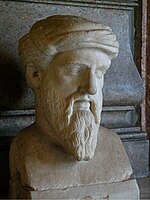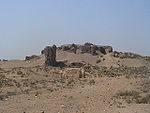6th century BC Chr.
Portal history | Portal Biographies | Current events | Annual calendar
◄ |
2nd mill. Chr. |
1st millennium BC Chr. |
◄ |
8th century BC Chr. |
7th century BC Chr. |
6th century BC Chr. |
5th century BC Chr. |
4th century BC Chr. |
►
The 6th century BC Chr. Began on January 1 v 600th And ended on December 31, 501 BC. Chr.

Age / Epoch
Some of the most important world religions and philosophies emerged almost simultaneously: Buddha in India / Nepal , Confucius in China and Pythagoras in Greece are contemporaries, probably Laozi in China and possibly even Zarathustra in Persia . The Delphic oracle of Apollo distinguishes itself as the most important Weissagungsstätte. The climax of what Karl Jaspers called the Axial Age .
The Celtic Hallstatt culture (8th – 6th centuries BC) prevails in large parts of Europe . The furnishings of the princely graves and residences from this time are evidence of extensive trade relations.
The Etruscan culture is at its height in Tuscany .
Cyrus II founds the great Persian empire , which his successors Cambyses II and Darius I expanded.
In China, the Zhou dynasty (1066–256 BC) reigns during the important cultural and historical period of the spring and autumn annals .
Events / developments
Greece
- 600-592 BC Chr .: First Holy War between Athens and Sikyon on one side and Chrisso on the other
- 594/593 BC Chr .: Comprehensive constitutional reform in Athens by Archon Solon , with which the participation of the people in political decisions is institutionalized. Associated with this is the reduction of social and economic tensions.
- 586 BC Chr .: Introduction of the Pythian Games
- 573 BC Chr .: First mention of the Nemean Games
- 560 BC Chr .: The Greek politician Peisistratos storms the Acropolis with a crowd of armed supporters and lets himself be proclaimed a tyrant. A little later he was overthrown by Lycurgus and Megacles .
- 559 BC Chr .: Another attempt to overthrow the Peisistratos (now in league with Megacles), but again fails.
- 550 BC Chr .: Abdera is destroyed by the Thracians .
- 546 BC Chr .: Third attempt to overthrow Peisistratos in Athens (supported by Lygdamos of Naxos ); this time he remains successful and establishes a tyranny .
- 538 BC Chr .: Polykrates becomes a tyrant on Samos . The poets Anakreon and Eupalinos work at his court ; the mathematician Pythagoras , on the other hand, leaves Samos and moves around 532 BC. BC to Croton in southern Italy , where he gathered the Pythagorean League around him.
- 534 BC Chr .: The first mention of Dionysia is considered to be the invention of the theater .
- 528 BC Chr .: After the death of Peisistratus, his sons Hippias and Hipparchus continue the tyranny.
- 520 BC BC: Cleomenes I becomes king in Sparta .
- 514 BC Chr .: Assassination of the Athenian tyrant Hipparchus by the tyrant murderers Harmodios and Aristogeiton
- 513 BC Chr .: Scythian campaign of the Persian king Dareios I ; an advance across the Danube fails, but Thrace and Macedonia become Persian.
- 510 BC Chr .: In Athens the tyrant Hippias is overthrown by a popular revolt supported by Cleomenes of Sparta ; Hippias flees to Persia. The reformer Kleisthenes was initially defeated by the oligarch Isagoras in the ensuing power struggle .
- 508/507 BC Chr .: Kleisthenes succeeds in driving Isagoras out. He introduces a comprehensive constitutional reform that provides for democratic innovations.
- 502 BC Chr .: Rebellion of the island of Naxos against the Persian rule
rest of Europe
- Around 600 BC BC: Beginning of the Celtic immigration to the Iberian Peninsula . The immigrants mix there with the Iberian indigenous population and form the Celtiberian civilization.
- 588 BC Chr .: Apollonia is founded by Doric colonists in the area of the Illyrians .
- Around 560 BC BC: Greek settlers found the Alalia colony on Corsica .
- Around 540 BC Chr .: The Greek colony Elea is founded in southern Italy .
- Around 540 BC Chr .: Etruscans and Carthaginians defeat the Greeks in the sea battle near Alalia (Corsica), the Greek settlers have to give up their colony.
- 525 BC BC: The Etruscans extend their sphere of influence to Campania .
- 510 BC BC: The city of Sybaris in southern Italy is destroyed in the war against the neighboring city of Kroton .
- Around 509 BC Chr .: fall of the last (Etruscan) king of Rome , Lucius Tarquinius Superbus . The city becomes a republic .
- 507 BC Chr .: On the Capitol in Rome is Jupiter temple consecrated.
- Around 503 BC Chr .: Lars Porsenna's attempt to restore the kingship in Rome is thwarted by the victory of the Latins and Greeks (under Aristodemos of Kyme ) at Aricia , in which Lars Porsenna's son perishes; he himself withdraws from Rome, which he had occupied.
Middle East
- 597 BC BC , March 16: Nebuchadnezzar II , king of Babylonia , conquers Jerusalem in his seventh year of reign and installs Zedekiah as king in the kingdom of Judah in place of Jehoiachin .
- 587/586 BC Chr .: Nebuchadnezzar II again conquered Jerusalem after an uprising. Beginning of the Babylonian exile for the Jewish people.
- 585 BC Chr., May 28th: A total solar eclipse , which the Greek scholar Thales is said to have predicted, leads, according to tradition, to the termination of the Battle of Halys between Lydia under Alyattes II and Medien under Kyaxares II. They then make peace and recognize Halys as a border river.
- 584 BC Chr .: Astyages becomes (last) king of the Medes.
- 562 BC Chr .: After the death of Nebuchadnezzar II (43rd year of reign) Amēl-Marduk ( accession year ) becomes king of Babylonia.
- 559 BC Chr .: Cyrus II becomes king of Persia .
- 555 BC Chr .: Nabonidus first year of reign as king of Babylonia .
- 553 BC BC: The Persian king Cyrus II conquers the Median city of Parsagadae.
- 550 BC Chr .: Victory of the Persians over the Medes, whose empire is incorporated into the Persian empire. Persia thereby becomes a neighbor of the Lydians.
- 541 BC Chr .: downfall of the Lydian empire under Croesus , see Battle of Pteria . The Greek cities of Asia Minor (except Miletus ) also become Persian.
- 539 BC BC: The Persian King Cyrus II conquers Babylonia.
- 530 BC Chr .: Cyrus II falls in the fight against a tribe of the eastern provinces, successor is Cambyses II.
- 523 BC Chr .: The wife Roxane of Cambyses II dies of a miscarriage in Nubia .
- 522 BC BC, March: The magician Gaumata poses as Bardiya , the (murdered) brother of the Persian king Cambyses, and rises against him. Cambyses was in Egypt at the time; he died in an accident in Syria in July. Against the false Bardiya, Dareios I , a nephew of Cambyses, rises up , who can beat Gaumata on September 29 at Pasargadae. However, he still has to assert himself against other pretenders to the throne, so that he did not take part until December 28, 521 BC Is generally recognized as a ruler.
- 521 BC Chr .: Darius I put down a rebellion of the Babylonians against Persian rule, which had broken out in the face of the Persian battles for the succession.
- 520 BC Chr .: The prophet Haggai calls in Jerusalem to resume work on the temple.
- 518/516 BC Chr .: The Persians under Darius I conquer the Indus valley .
- 515 BC BC, March 12th: Dedication of the second temple in Jerusalem
Rest of Asia
- 575 BC Chr .: The Battle of Yanling is Chu of Jin defeated.
- 534 BC Chr .: Siddhartha Gautama Buddha became an ascetic at the age of 29 in search of salvation .
- 528 BC Chr .: At the age of 35, Siddhartha Gautama Buddha achieved complete enlightenment.
Africa
- Around 596 BC BC: The Phoenicians sail around Africa .
- 595 BC Chr .: Psammetich II becomes king of Egypt as successor of Necho II.
- 592 BC BC: The Egyptians conquer Napata in the kingdom of Kush ( Sudan ), which then has to move its capital to Meroe .
- 589 BC Chr .: death of Psammetich II on February 9th (converted to today's calendar - the date is known exactly to the day); Apries becomes King of Egypt.
- 571 BC Chr .: Failed campaign of the Egyptians under Apries against Cyrene .
- 569 BC Chr .: After an army revolt, the general Amasis drives out Apries and becomes King of Egypt in his place.
- 526 BC Chr .: Psammetich III. succeeds Amasis as King of Egypt.
- 525 BC BC, May: The Persians under Cambyses II defeat the Egyptians at Pelusium and conquer the country.
religion
- 543 BC Chr .: Beginning of the Buddhist calendar . It is based on the Buddha's entrance into nirvana ; the year is determined by Sinhalese monks and independent of historical events: Buddha's death year is probably 483 BC. Chr.

Personalities
- Anakreon , Greek poet (* around 580 BC; † around 495 BC)
- Anaximander , Greek natural philosopher (* 610 BC; † 546 BC)
- Anaximenes , Greek natural philosopher (* 585 BC; † 525 BC)
- Andokides , Greek potter
- Annei , 3rd Tennō of Japan (* 577 BC; † December 6, 511 BC)
- Aesop , founder of fables
- Darius I , Persian king and reorganizer of the Persian empire († 486 BC)
- Epicharmos , Greek philosopher , comedy writer and doctor (* around 540 BC; † around 460 BC)
- Euphronios , Greek vase painter
- Euxitheos , Greek potter
- Siddhartha Gautama (* around 560 BC; † 483 BC), founder of Buddhism
- Kachrylion , Greek potter
- Kleisthenes of Athens , Greek reformer and founder of democracy (* around 570 BC; † around 507 BC)
- Confucius , Chinese philosopher (* 551 BC; † 479 BC)
- Croesus , Lydian king (* around 595 BC; † around 546 BC)
- Cyrus II , Persian king and founder of the ancient Persian Empire († 529 BC)
- Laozi ( Lao Zi ) philosopher, founder of Daoism
- Nabonidus (* after 609 BC; † at the earliest 539 BC)
- Nebuchadnezzar II , King of Babylonia (* 605 BC; † 562 BC)
- Nikosthenes , Greek potter
- Oltos , Greek vase painter
- Polykrates , Greek tyrant on the island of Samos
- Psiax , Greek vase painter
- Pythagoras of Samos , Greek philosopher and scientist (* around 580 BC; † around 496 BC)
- Prophet Zechariah
- Sappho , Greek poet
- Solon , Greek statesman (* 638 BC; † 559 BC)
- Sunzi , Chinese military philosopher ("The Art of War")
- Thales von Milet , Greek natural philosopher (* 624 BC; † 546 BC)
- Themistocles , Greek general (* around 525 BC; † around 460 BC)
- Xerxes I , Persian king (* around 519 BC; † 465 BC)
Inventions and discoveries
Web links
Individual evidence
- ^ Howard M. Hensel: The Prism of Just War: Asian and Western Perspectives on the Legitimate Use of Military Force . Ashgate, 2010. ISBN 0-7546-7510-6 , p. 208.








